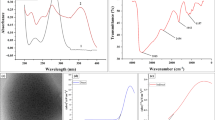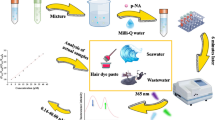Abstract
A simple way of directly observing antigen-antibody binding in a reverse micellar system,n-octane containing reverse micelles of aerosol OT (AOT), using the hydrophobic pesticide propazine as antigen, is described. We observed two processes during fluorescein-labeled propazine (FP)-antibody (Ab) interaction in reverse micelles: (1) quenching of the fluorescence of FP after mixing of Ab and FP (due immune complex formation) and (2) restoration of FP fluorescence after addition of excess propazine to the immune complex formed. We found that the quenching efficiency depends on both the properties of the reverse micellar system (surfactant concentration, hydration degreeW 0 = [water]/[surfactant]) and the structure of the labeled antigen. A quenching fluoroimmunoassay of propazine both in apolar organic solvents and in water is developed. The method is homogeneous. The quenching time is 10–30 min, and the detection limit of propazine is 100 nM (20 Μg/L) in organic solvent and 10nM (2 Μg/L) in water. Propazine can be added to the reverse micellar system when dissolved in AOT/octane, or in an octane/chloroform mixture, or in chloroform. This makes possible the use of the analysis directly for pesticide extracts in nonpolar organic solvents.
Similar content being viewed by others
Abbreviations
- Ab:
-
polyclonal antibodies against propazine
- AOT:
-
aerosol OT, sodium bis(2-ethylhexyl)sulfosuccinate
- DL:
-
detection limit
- ELISA:
-
enzyme-linked immunosorbent assay
- Fab:
-
fragment antigen binding
- FP:
-
propazine labeled with fluorescein
- QFIA:
-
quenching fluoroimmunoassay
- W0 :
-
surfactant hydration degree (W 0= [H2O]/[surfactant])
References
K. Martinek, A. V. Levashov, N. L. Klyachko, Yu. L. Khmelnitsky, and I. V. Berezin (1986)Eur. J. Biochem. 155, 453–468.
P. L. Luisi and L. J. Magid (1986)CRC Crit. Rev. Biochem. 50, 409–474.
A. N. Eryomin, M. I. Savenkova, and D. 1. Metelitsa (1986)Bioorg. Khim. (Russ.) 12, 606–612.
Ch. N. Durfor, R. J. Bolin, R. J. Sugasawara, and R. J. Massey (1988)J Am. Chem. Soc. 110, 8713–8714.
A. V. Kabanov, M. M. Khrutskaya, S. A. Eremin, N. L. Klyachko, and A. V. Levashov (1989)Anal Biochem. 181, 145–148.
N. P. Groome, M. Vacher, C. Nicot, and M. Waks (1990)Biochem. Int. 21, 1–7.
A. N. Eryomin, E. I. Karaseva, and D. I. Metelista (1991)Doklady Akad. Nauk Belarusi (Russ.) 35, 549–552.
N. V. Girina, E. I. Karaseva, and D. I. Metelitsa (1994)Biochemistry (Moskow) 59, 1397–1402.
E. G. Matveeva, N. S. Melik-Nubarov, P. Miethe, and A. V. Levashov (1996)Anal Biochem. 234, 13–18.
E. G. Matveeva, J. V. Samsonova, and S. A. Eremin (1996)Bioorg. Khim. (Russ.) 22, 931–937.
J. M. Francis and D. H. Craston (1994)Analyst 119, 1801–1805.
T. Giersch (1993)J. Agr. Food Chem. 41, 1006–1011.
M. Wortberg, M. H. Goodrow, S. J. Gee, and B. D. Hammock (1996)J. Agr. Food Chem. 44, 2210–2219.
S. A. Eremin (1995) in J. O. Nelson, A. E. Kam, and R. B. Wong (Eds.),Immunoanalysis of Agrochemicals, ACS Symposium Series 586, American Chemical Society, Washington, DC, pp. 223–234.
D. Lopatin and E. W. Voss, Jr. (1971)Biochemistry 10, 208–213.
D. M. Kranz, J. H. Herron, and E. W. Voss, Jr. (1982)J. Biol. Chem. 257, 6987–6995.
J. H. Herron, D. M. Kranz, D. M. Jameson, and E. W. Voss, Jr. (1986)Biochemistry 25, 4602–4609.
W. D. Bedzyk, C. A. Swindlehurst, and E. W. Voss, Jr. (1992)Biochim. Biophys. Acta 1119, 27–34.
P. R. Droupadi, T. Nanavaty, C. Smith, D. D. Johnson, M. Adamczyk, and D. S. Linthicum (1995)J. Fluoresc. 5, 273–277.
Author information
Authors and Affiliations
Rights and permissions
About this article
Cite this article
Matveeva, E.G., Samsonova, J.V. & Eremin, S.A. A quenching fluoroimmunoassay for analysis of the pesticide propazine in an apolar organic solvent, reverse micelles of AOT inn-octane: Effect of the micellar matrix and labeled antigen structure. J Fluoresc 7, 211–216 (1997). https://doi.org/10.1007/BF02758221
Received:
Accepted:
Issue Date:
DOI: https://doi.org/10.1007/BF02758221




